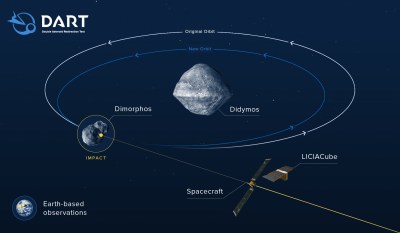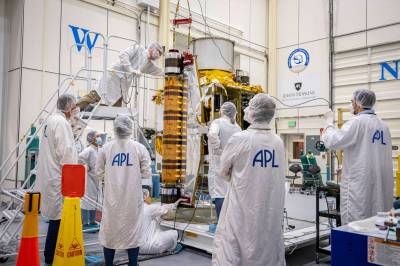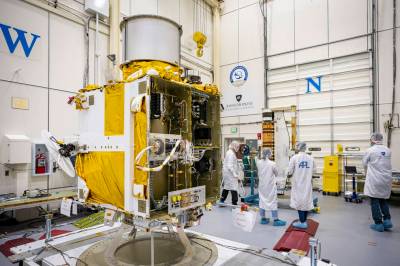The world faces many terrestrial crises right now, so it’s easy to forget that giant space rocks may one day threaten the very existence of entire civilizations. Yes, the threat of asteroid strikes is a remote one, but nevertheless something humanity may have to face one day, and one day soon.
NASA takes the issue seriously, and has staffed its Planetary Defence Coordination Office since 2016. In service to these efforts, it’s also developing a mission to research how dangerous androids may be deflected. The Double Asteroid Redirection Test, or DART, is set to launch within the next year.

DART aims to change the path of an asteroid through kinetic impact, or, in layman’s terms, by smashing into it. The craft will target Didymos, a binary asteroid system consisting of Didymos itself and the smaller asteroid Dimorphos in orbit around it. The asteroid will pass near Earth, at a distance of 11 million kilometres, without being on a collision trajectory, making it a good candidate for humanity’s first attempt at asteroid deflection.
Didymos, the larger asteroid of the pair measures 780 meters in diameter, while Dimorphos is significantly smaller at just 160 meters across. The DART craft will aim to hit Dimorphos head on, and in doing so, reduce its orbital period around Didymos. This change in the orbit will be measured from observatories on Earth in order to gauge the success of the mission.
The main body of the DART spacecraft measures just 1.2 x 1.3 x 1.3 meters, and the craft as a whole weighs approximately 500 kg. DART is intended to impact Dimorphos at a speed of 6.6 km/s. In doing so, it will alter the orbital period by 4.2 minutes, from 11.9 to 11.8 hours. The change in the orbital period is expected to be on the order of 10 minutes or so. It may not sound like a big change, but the hope is that over millions of kilometers, it will add up to a significant shift in the original trajectory of the asteroid system.

The DART mission will also serve to trial several innovative technologies. New to the project are the Roll Out Solar Arrays, or ROSA. These flexible solar panels can be rolled up for launch, and deployed once the craft is in space. They’re also lighter and more compact than traditional arrays, while also being stiffer as well. The twin roll-out panels will each span 8.5 meters when fully unfurled. Similar technology was recently deployed to the ISS, which has had roll-out panels laid over its original rigid solar panels to improve the power budget of the aging space station. The ROSA arrays will also feature a small section to trial Transformational Solar Array technology, which uses reflective concentrators combined with high-efficiency solar cells to potentially provide triple the power available from a typical solar array.
Propulsion is via NASA’s NEXT-C xenon-fueled gridded ion thruster. This uses electric fields to accelerate ions to huge velocities on the order of 40 km/s in order to generate thrust for the spacecraft. While the thrust generated is small, on the order of a few hundred milliNewtons, the ion thruster is very fuel efficient. Thus, it can be run for a long time to slowly accelerate the craft to great speed. We’ve featured a run down on the technology before, which promises to be useful on a variety of long-range space missions.
In order to target the asteroid and hit it square and true, the DART mission needs a top-notch navigation system. The craft thus features the Didymos Reconnaissance and Asteroid Camera for Optical, or DRACO. This device is for terminal navigation to ensure DART makes a good solid impact with the asteroid. The high-resolution camera feeds into the SmartNAV autonomous guidance system which will control the space craft in its final four hours of flight towards the asteroid. Having the spacecraft guide itself is important, as with the distances involved, the round trip delay for commands from Earth would be 1.5 minutes. Thus, the craft must fly itself to its target.

The DART mission will also carry LICIACube, a small cube sat built by the Agenia Spaziale Italiana (ASI). Five days prior to impact, LICIACube will be deployed in order to image the impact of DART into Dimorphos. The aim is to capture shots of the impact site itself, as well as the cloud of ejected material in the immediate wake of the impact. This should provide plenty of material for analysis as to the effectiveness of the DART mission at redirecting the asteroid.
It’s an interesting approach to the problem of asteroid deflection. Hitting asteroids with relatively small spacecraft nice and early in their approach is something that should be readily achievable with current technology, as DART will demonstrate. It’s also less desperate and drastic than other ideas involving the last-ditch use of nuclear weapons to turn away or destroy incoming objects.
At present, there are no major asteroids expected to hit Earth in the near future. However, that’s not to say there aren’t plenty of asteroids floating around out there. The Planetary Defense Coordination Office had detected over 19,000 near-Earth asteroids by the start of 2019, and 30 new objects are detected on average each week. These detection and tracking efforts are key to planetary defense. The earlier we’re aware of an object heading towards Earth, the more time we have to plan a mission to deal with it, and more options are on the table. Let the asteroid get too close, and the amount of energy needed to deflect it away from Earth becomes much greater, and the task much harder.
While the effect of DART will be small, it’s only humanity’s very first attempt to redirect an asteroid. The brave people of Earth will be able to rest easier, knowing that great minds are tackling the difficult problem of how to protect us from the big rocks from above.
















“It’s also less desperate and drastic than other ideas involving the last-ditch use of nuclear weapons to turn away or destroy incoming objects.”
https://youtu.be/Y4iGdyni_8g
Considering the size of a lot of them, I’m not sure even nukes would make a difference.
The nukes would be successively set off in a crater to essentially act as a thruster. I imagine the thrust and efficiency could actually be pretty good. That combined with the fact that only a fraction of 1m/s delta v might be required makes it seem possible to me. I’d love to see someone do a calculation on it.
IIRC, Bruce Willis is already working on that.
No, that’s an episode of Stargate SG-1 (although they planned on using a single nuke). Turns out that doing a hyperdrive jump through the Earth works better.
Right!, this is all fantasy. Well probably put it right into Earth’s path.
Awesome, it’s a start!
Maybe someday we can clean everything else out of the Earth’s orbit so that it can finally be a real planet!
Ha ha. Fat chance.
Awesome, deflecting dangerous androids.
Could someone look at the size of an incoming asteroid and where it would hit and *cough* accidentally let it through?
Or deflect it to stop it missing?
With the proper maths you could probably drop it on the city of your choice, 30,000,000 Megatons of impact energy or it’s free!
Was it not in Arthur C Clark’s “The Moon is a Harsh Mistress” that the moon colony launched massive refined metal slugs Earthward on electromagnetic launchers, for shallow sea delivery? Relations deteriorated, and the threatened delivery point changed to cities, IIRC. (It’s at least 40 years since I read the story.)
Now, was that also the one in which the lunar computer network became sentient? (Must find a copy, and re-read.)
It was Heinlein’s book.
They were already sending containers of grain, they suggested sending rocks.
That was the beginning of the end for me: “So you’re shipping water, fertilizer and seed uphill to Luna, then unrefined product back to Earth? I get the CO2 scrubbing part of that, but how will you ever pay for fuel ,whatever that is?”
I can’t respond directly to “Thinkerer” but it’s explained in the book that water and fertilizer are produced locally on the moon, and the resulting crop is sent down Earth’s gravity well by slingshot. The impetus for the uprising on the moon is that sending the majority of crops down the gravity well for much longer will make the moon into a barren husk, and once that happens the people who live on the moon will be unable to go to earth because their bodies are used to the much lower lunar gravity. So they’d starve and die.
Was gonna say, the belters slinging rocks in the expanse was super cool (and horrifying).
What’s so drastic about using nukes? This is deep space, so it’s not like we’d have to worry about collateral damage. I think the reason they didn’t just for this test is just because this is much simpler. A nuke would have to be carefully landed on the surface at just the right spot, not to mention there would be a lot of red tape regarding the handling of a live nuke; and one designed for absolute maximum yield with no regard for fallout at that.
Nukes would be OK as long as the launch of the nuclear equipped rocket goes off safely. [insert image of rocket exploding on launch pad] If things go wrong, the launch area would be showered in radioactive material — right?
A warhead like the Mk83 is actually very safe thanks to a combination of TATB insensitive high explosive, fire resistant pit with a high temperature coating, single point safety, etc. A smart test for planetary defense would involve developing and testing all the non nuclear components of a nuclear deflection vehicle including all the required conventional ordnance involved. This would also avoid the problems of flying nuclear material until and unless a planetary threat makes it necessary.
For certain classes of asteroid or comet, nuclear explosives are sometimes the only way to deliver sufficient energy into shifting the target. Less energetic deflection technologies (kinetic impact, albedo modification, etc.) should also be developed, of course. No sense cracking a nut with a sledgehammer.
This is true (5/5).
Would buy again. Much better deal than my Tsar bomba reproduction.
Probably would be launched in a remote place, and because it’s a worthwhile risk considering the alternative asteroid.
Makes me wonder if using a nuke directly on an asteroid would be the best idea, considering we wouldn’t have a great idea of it’s internal structure a nuke could just shatter it, mo’ ‘roids, mo’ problems. I think a better idea for a big asteroid would be a “Scotch Egg” a nuke embedded in a small asteroid with mounted thrusters. When a big rock is seen you send the egg towards it and when it’s an an optimal distance you detonate the egg and the vaporized mass will push more evenly against the asteroid, moving but not breaking it.
The scenario most often bandied about involves a warhead or series of warheads being detonated at a standoff distance ablating material off the surface via X-ray and neutron heating. Sometimes efficiency is improved using an existing crater or a crater made by a kinetic impact to focus the ablated material. The standoff distance is tailored so the surface pressure from ablation is well below the threshold where the target will fracture.
I can see that but seem a large wave of superheated plasma would give a better kinetic “kick” over the entire exposed surface, meaning using a smaller nuke, and probably less need for precision, but I’m no engineer. Still the “Scotch Egg” sounds like it would be fun to use in a Sci-Fi story.
The Egg cannae tak’ it, Cap’n!!!!
Sounds like a waste of good Scotch to me…
B^)
Nice artwork, Joe Kim!
I loved the artwork as well, then I realized that the flights on a dart won’t work in the vacuum of space.
Give them large enough area and they’ll point it towards the nearest stellar object (solar wind and light pressure) it’s maybe not the “pointing forward” you want but it’s the one you’ll get.
DRACO is a bit of a forced acronym. May I suggest “Didymos Optical Reconnaissance Camera”, or DORC?
You mean NASA is
Funny how no one picked out the Dangerous Androids in the text.
“Exterminate!…Exterminate!…”
With enough eyes all autocorrects are shallow.
aster la vista , maybe?
roid rage
Just want to be clear here. You think climate change is NOT highly covered in the media and that it poses is a higher risk to humanity in the next 20 years than the extinction level event an asteroid could cause?
Arthur C Clarke envisioned this happening and such a program being created. The date the big rock hit was 9-11. A wake-up call if ever there was one. Double that this Saturday as we remember and move on.
It’s a very clever test, and will give very accurate results, measureable against prediction.
On the scale of existential threats, climate change pales in comparison to asteroid impact. The earth’s inhabitants have already survived several climate change events (e.g., the little ice age), but one asteroid impact wiped out the dinosaurs.
Well, this is all new to me interesting nonetheless just recently over the last 4 or 5 yrs got intrigued & interested in astronomy & my curiosity is peaked NOW! I say whatever can be done to protect and/or prevent destruction of Mother Earth should be explored!
Let’s hope all of the NASA project contractors are using the same measurement units (either SI or Imperial, but not both).
firstly i hope the impact is taking place as dimorphos and didymos are leaving the blue ball planet solar system area
rather than
as they are approaching our earth system area
secondly i say
give dimorphos a small push by a pack of 10 rockets and make them return to earth
dont give destruction to both objects
push and shove leverage gives motion power on the outward trajectory track
so if something goes wrong it happens away from us
rather than it happens approaching us
and 19 rockets are ready for the next intruder on our way someday sooner than you know
Or, hear me out, we send up two teams of oil drillers with zero experience as astronauts and give each team a live nuclear weapon, with no reliable way of telling the other team if they initiated the timer on theirs, and we also let the ground team remotely set off the nukes if they are unhappy with the speed the holes are drilled.
I’d rather get hit by an asteroid than concede that “NASA are” is correct. Heads up..incoming.